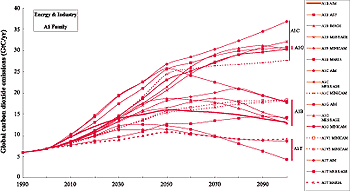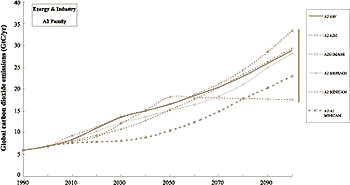5.3.1.1. A1 Scenario Family
Rapid economic growth in the A1 family scenario leads to high energy demand
and hence to a steep increase in CO2 emissions in the first decades of the
21st century. Structural changes in the energy supply become effective only in
the longer term because of the inertia caused by long periods of capital turnover.
With respect to alternative energy supply technologies, the A1B scenario group
assumes a "balanced" approach, in which none of these technologies gain an overwhelming
advantage. This scenario group includes the A1B marker scenario developed using
the AIM model (Jiang et al., 2000). In addition to the A1 scenario group, variations
that assumed fast advancements in specific energy supply sectors were explored
(renewables, A1T; oil and gas, A1G; coal, A1C) (see Chapter
4).
|

Figure 5-3a: Global CO2 emissions from fossil
fuels and industry in the SRES A1 scenario family (standardized). The
marker scenario is shown with a thick line without ticks, the globally
harmonized scenarios with thin lines, and the non-harmonized scenarios
with thin, dotted lines (see Table 4-3). In the
SPM, A1C and A1G scenarios are merged into one fossil-intensive A1FI scenario
group (see also footnote
2).
|
In the A1B-AIM marker scenario, the global average per capita final energy
demand grows from 54 GJ in 1990 to 115 GJ in 2050 and to 247 GJ in 2100. Meanwhile,
the final energy carbon intensity declines relatively slowly until 2050 (from
the current 21 tC per TJ of final energy to 16 tC per TJ), which results in
a steep increase in CO2 emissions in the first decades of the 21 st century.
After 2050, when structural changes in the energy sector take effect, carbon
intensity declines rapidly to reach 7.5 tC per TJ. This more than offsets growing
energy demand from a contracting but increasingly prosperous population, so
that carbon emissions decline between the years 2050 and 2100. Emissions peak
around 2050 at a level 2.7 times (16 GtC) that of 1990 and fall to around 13
GtC by 2100, which is about twice the current level (Figure 5-3a). The total,
cumulative 1990 to 2100 carbon emissions4
in the A1B-AIM scenario equal 1499 GtC (cumulative emissions from energy and
industry only amount to 1437 GtC).
Energy-related carbon emissions vary widely across alternative A1 group scenarios.
The smallest differences with respect to the A1B marker scenario (A1B-AIM) are
in the A1B-MESSAGE (Roehrl and Riahi, 2000) scenario, which used harmonized
input assumptions for population, GDP, and final energy use at the level of
the four regions (see Chapter 4). Resultant energy-related
carbon emissions in A1B-MESSAGE closely match those of the A1B-AIM scenario,
reaching 13.8 GtC by 2100, which indicates that energy supply technologies agree
well between the AIM and MESSAGE models.
While still adhering to the "balanced" supply-mix assumption (see Section
4.3.1), other scenarios within the A1 balanced group span a larger range
of future emissions around the A1B-AIM scenario. In part this results from different
assumptions on global and regional GDP growth and energy-intensity improvements,
but also from alternative interpretations of how to translate the concept of
a "balanced" pathway of technological change (as described in the A1 scenario
storyline) into model-specific technology assumptions.
Two alternative A1 scenario groups, A1G (oil and gas) and A1C (coal), explore
high-fossil futures and one group, A1T, explores advanced technology futures.
A1G and A1C have been combined into one fossil intensive scenario group A1FI
in the SPM (see also footnote
2). Energy-related carbon emissions vary widely
across these scenario groups in conjunction with the scenario assumptions as
to roles of different energy sources (Figure 5-3a). The high fossil scenarios
explore worlds that consume vast amounts of coal, or oil and gas, while with
the advanced technology assumptions the role of fossil fuel declines strongly
as nuclear and/or renewable sources are favored to supply the reduced final
energy demand.
The A1 fossil scenarios have essentially the same population, GDP, and final
energy demand as the A1B marker, but have a primary energy system that relies
mainly on fossil fuels. Based on cumulative CO2 emissions, scenarios from the
A1 fossil groups (A1G and A1C) fall within the high emissions category, with
A1G-MiniCAM falling roughly in the middle of the range spanned by the six A1
fossil scenarios (Table 5-2). The primary energy
system in the A1G-MiniCAM scenario emerges as a result of rapid increases in
the efficiency with which fossil resources can be recovered, especially in the
most expensive grades of these resources; unconventional resources play an increasingly
important role toward the end of the 21st century.
These rapid technical changes, as well as relatively low rates of growth in
the productivity of biomass and other non-fossil sources, imply a world that
is heavily reliant on oil and gas. The three coal-based scenarios in this group
(A1C-MESSAGE, A1C-MiniCAM, and A1C-AIM) assume rapid increases in the efficiency
of synthetic fuel production, as well as relatively limited oil and gas resources.
Three advanced technology or A1T scenarios fall in either the "low" or the
"medium-low" cumulative emissions categories (Table
5-2). The A1T-MARIA scenario (Mori, 2000) achieves very low carbon emissions
through the combination of a low final energy use (54% of that in A1B-AIM) and
a rapid increase in the importance of non-fossil energy technologies in the
primary energy system (81% by 2100).
The resultant CO2 emissions range of all the A1 family scenarios is so wide
that most of the remaining SRES scenarios fall within its bandwidth, from 4.3
to 37 GtC in 2100. The total cumulative carbon emissions of the A1 family scenarios
also span a very wide range, from around 1000 GtC to more than 2500 GtC (Figure
5-1, Table 5-2).
5.3.1.2. A2 Scenario Family
|

Figure 5-3b: Global CO2 emissions from fossil
fuels and industry in the A2 scenario family (standardized). The marker
scenario is shown with a thick line without ticks, the globally harmonized
scenarios with thin lines, and the non-harmonized scenarios with thin,
dotted lines (see Table 4-3).
|
In the A2 scenario family, alternative energy technologies develop relatively
slowly and fossil fuels maintain their dominant position in the energy supply
mix. As oil and gas resources become scarcer and non-fossil alternatives remain
underdeveloped, coal gains the leading role. Its share in the energy mix ranges
from 45% to 52% in the harmonized scenarios (A2-ASF, A2-MESSAGE) and in other
scenarios with similar input assumptions (A2-MiniCAM and A2-AIM).
Global CO2 emissions in the A2 marker scenario implemented using the ASF model
(Sankovski et al., 2000) increase by more than fourfold over their 1990 level,
to reach 29 GtC by 2100 (Figure 5.3b). Total cumulative carbon emissions from
the A2- ASF scenario amount to 1860 GtC by 2100.
In other A2 scenarios, CO2 emissions range from 17 GtC (A2G-IMAGE5)
to 33 GtC (A2-AIM) by 2100. The harmonized A2-MESSAGE scenario and the A2-MiniCAM
scenario have very similar global CO2 emissions as compared to the marker. Slightly
higher emissions, primarily caused by higher primary energy use, are generated
in the A2-AIM scenario. Unlike the rest of the A2 family scenarios, the A2G-IMAGE
scenario yields constant emissions after 2050. This emission trajectory is explained
by the combination of a lower energy demand and a larger share of natural gas
in the energy supply mix (see Chapter 4 for more details).
Total cumulative carbon emissions in the A2 scenario group range between 1710
and 1860 GtC by 2100.
A variant of the A2 storyline, developed with the MiniCAM model (A2-A1-MiniCAM),
explores a world in which economic growth and population follow a "hybrid" trajectory,
which have traits of both the A2 and A1 storylines. As described in Box
4-6, A2-A1-MiniCAM has a lower population than other scenarios of the A2
family, and a slower rate of economic growth in the first half of the 21st century.
These in turn limit the growth in final energy demand until after the onset
of rapid economic growth around 2050. Emissions also rise rapidly during the
post-2050 period, as the large growth in energy consumption results mostly from
coal, oil, and gas.
Two out of the six A2-family scenarios, A2-ASF and A2-AIM, fall into the "high"
cumulative CO2 emissions category. Three scenarios, A2-MESSAGE, A2-IMAGE, and
A2-MiniCAM, belong to the "medium-high" category, and only the A2-A1- MiniCAM
scenario with its drastically different assumptions about key driving forces
falls in the "medium-low" category.
|